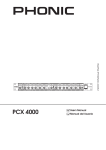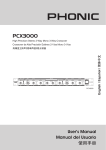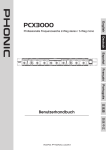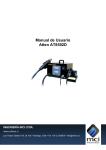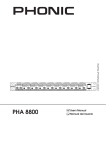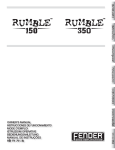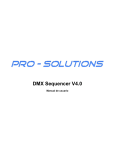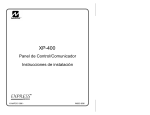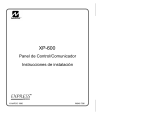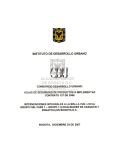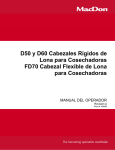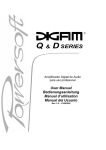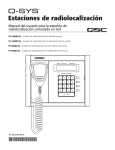Download PCX 3000
Transcript
PCX 3000 User's Manual Manual del Usuario English PCX 3000 High Precision Stereo 2-Way Mono 3-Way Crossover Crossover de Alta Precisión Estéreo 2-Vías Mono 3-Vías Español ENGLISH . . . . . . . . . . . . . . . . . . . . . . . . . . . . . . . . . . . . . . . . . . . . . . . . . . I ESPAÑOL ..................................................II V1.1 06/01/2012 English USER'S MANUAL CONTENTS INTRODUCTION 1 FEATURES 1 QUICK SETUP 1 OPERATING THE PCX3000 1 2-Way Stereo Operation 1 Front Panel 1 Rear Pane 2 3-Way Mono Operation 3 Front Panel 3 Rear Panel 4 APPLICATION 4 SPECIFICATIONS 5 APPENDIX DIMENSIONS 1 BLOCK DIAGRAM 2 Phonic preserves the right to improve or alter any information within this document without prior notice PCX3000 IMPORTANT SAFETY INSTRUCTIONS English The apparatus shall not be exposed to dripping or splashing and that no objects with liquids, such as vases, shall be placed on the apparatus. The MAINS plug is used as the disconnect device, the disconnect device shall remain readily operable. Warning: the user shall not place this apparatus in the can be easily accessible. area during the operation so that the mains switch 1. Read these instructions before operating this apparatus. CAUTION 2. Keep these instructions for future reference. RISK OF ELECTRIC SHOCK DO NOT OPEN 3. Heed all warnings to ensure safe operation. 4. Follow all instructions provided in this document. 5. Do not use this apparatus near water or in locations where condensation may occur. 6. Clean only with dry cloth. Do not use aerosol or liquid cleaners. Unplug this apparatus before cleaning. 7. Do not block any of the ventilation openings. Install in accordance with the manufacturer’s instructions. CAUTION: TO REDUCE THE RISK OF ELECTRIC SHOCK, DO NOT REMOVE COVER (OR BACK) NO USER SERVICEABLE PARTS INSIDE REFER SERVICING TO QUALIFIED PERSONNEL The lightning flash with arrowhead symbol, within an equilateral triangle, is intended to alert the user to the presence of uninsulated “dangerous voltage” within the product’ 8. Do not install near any heat sources such as radiators, heat registers, stoves, or other apparatus (including . 9. Do not defeat the safety purpose of the polarized or grounding-type plug. A polarized plug has two blades with one wider than the other. A grounding type plug has two blades and a third grounding prong. The wide blade or the third prong is provided for your safety. If the provided plug does not into your outlet, consult an electrician for replacement of the obsolete outlet. 10. Protect the power cord from being walked on or pinched particularly at plug, convenience receptacles, and the point where they exit from the apparatus. 11. Only use attachments/accessories manufacturer. magnitude to constitute a risk of electric shock to persons. The exclamation point within an equilateral triangle is intended to alert the user to the presence of important operating and maintenance (servicing) instructions in the literature accompanying the appliance. WARNING: To reduce the risk of or electric shock, do not expose this apparatus to rain or moisture. CAUTION: Use of controls or adjustments or performance of procedures other than those may result in hazardous radiation exposure. by the 12. Use only with a cart, stand, tripod, bracket, or table by the manufacturer, or sold with the apparatus. When a cart is used, use caution when moving the cart/apparatus combination to avoid injury from tipover. 13. Unplug this apparatus during lighting storms or when unused for long periods of time. 14. Refer all servicing to service personnel. Servicing is required when the apparatus has been damaged in any way, such as power-supply cord or plug is damaged, liquid has been spilled or objects have fallen into the apparatus, the apparatus has been exposed to rain or moisture, does not operate normally, or has been dropped. PCX3000 QUICK SETUP Congratulations on your purchase of the PCX3000, a quality high precision 2-way stereo 3-way mono crossover with a multitude of built-in features, such as low pass filters, phase invert switches, and an additional subwoofer channel. This user ’s manual is specially designed to provide you with the best possible information on using the device. We strongly suggest reading the manual carefully before attempting to handle this device, and then store it an easily accessible place for future reference. 1. Make sure your unit is off. Preferably remove the AC power cable. FEATURES 2. Connect your required output device to the PCX3000’s input connector. Commonly, this would be a mixer’s auxiliary or main output. 3. Connect all of your required input devices to the device’s output connectors. Commonly this would be amplifiers or active speakers/subwoofers. 4. Set the mode button on the rear to your needs. There are two modes total: 2-way stereo and 3-way mono. 5. Turn your devices on in this order: instruments, mixer, signal processors (including the PCX3000), amps/speakers. l Professional, high-precision stereo 2-way/mono 3-way crossover with separate subwoofer output l Separate subwoofer section with independent frequency control l World-class performance 24dB per octave Linkwitz-Riley filters l Absolutely flat summed amplitude response, zero phase difference l Individual output level controls for all bands l Individual output mutes for easy band adjustment l Individual phase reverse switches for instant phase correction l Switchable 25Hz subsonic filter on each input for lowfrequency driver protection l Servo-balanced, XLR connectors for all inputs and outputs 2-Way Stereo Operation l Ultra-high precision potentiometers for ultimate accuracy and repeatability l Ultra low-noise audio operational pre-amplifiers for outstanding sound performance l Illuminated switches for secure operation in dark stage environments Set the PCX3000 to 2-way stereo by ensuring the Mode button on the rear of the device is pressed down. When set correctly, the stereo LED on the front of the device will light up, as well as the corresponding function buttons. When set to stereo, both channels will work in an identical manner. l High-quality components and exceptionally rugged construction for long life and reliability Front Panel l Shielded toroidal mains transformer for minimal noise interference This control will adjust the input gain between -12 and +12 dB. OPERATING THE PCX3000 As the PCX3000 runs in a variety of different modes, we have separated this user’s manual by these different modes and highlighted the control elements pertaining to each mode as to help better make the distinction between critical Note: on the rear of the device, the labels located above or below any of the connectors refer to different crossover modes available. Ensure the MODE switch and the corresponding connectors are properly configured as to prevent damage occurring to your speakers. 1. Input Control 2. Low Cut Button Pushing this button will activate a low cut (high pass) filter, set at 25 Hz, which will help protect woofers from extremely low frequency signals. 3. Low/High Crossover Frequency Control This control will determine the crossover frequency between the low and high frequency signals. When the Crossover Frequency button on the rear of the device is pushed in, the frequency range is multiplied by a factor of 10. PCX3000 English INTRODUCTION 5 8 12 English 1 2 3 4 6 7 9 10 11 4. Low Output Control Rear Panel This controls the level of the low-band output between -6 and +6 dB. 14. AC Connector and Fuse Holder 13 This button reverses the phasing of the low-band output, making the signal appropriate for out-of-phase or incorrectly wired speakers. This connector is used to supply power to the PCX3000 through the AC cable provided along with this unit. The fuse holder located below this connector is used to house the connector’s fuse. If for some reason the fuse blows, replace it with a fuse of identical type and rating. 6. Low Mute Button 15. High Output Connectors Pushing this button will mute the low-band signal. This connector will output the high-band signal. 7. High Output Control 16. Low Output Connectors This controls the level of the high-band output between -6 and +6 dB. This connector will output the low-band signal. 8. High Phase Invert Button Pushing this button will raise the control range of frequencies adjustable by the high/low crossover frequency control by 10 times (ie. when the button is released, the control range will be between 44 and 930 Hz; pushed-in, the range will be between 440 Hz and 9.3 kHz). 5. Low Phase Invert Control This button reverses the phasing of the high-band output, making the signal appropriate for out-of-phase or incorrectly wired speakers. 9. High Mute Button 17. Crossover Frequency Button 18. Input Connector Pushing this button will mute the high-band signal. 10. Subwoofer Crossover Frequency Control This control will determine the crossover frequency between the low and subwoofer frequency signals between 10 and 215 Hz. 11. Subwoofer Gain Control This control is used to set the output level of the subwoofer output. 12. Subwoofer Phase Invert Button Users can connect their balanced or unbalanced input signals here. 19. Mode Button This button determines the operating of the crossover. For 2-way stereo operation, the button should be pressed. Release, the PCX3000 will be set to 3-way mono. Note: Be sure to turn your system off before changing the setting of this button as it produces interference that may have a negative effect on speakers or other equipment. This button reverses the phasing of the subwoofer output, making the signal appropriate for out-of-phase or incorrectly wired speakers. 13. Subwoofer Mute Button 20. Subwoofer Output Connectors This connector will output the subwoofer signal. This signal remains constant when in mono or stereo mode. Pushing this button will mute the subwoofer signal. 14 15 16 17 18 19 20 PCX3000 5 2 3 4 6 14 15 17 9 7 8 10 12 11 English 1 16 13 3-Way Mono Operation 8. Mid Output Control Set the PCX3000 to 3-way mono by releasing the Mode buttons on the rear of the device. When set correctly, the mono LED on the front of the device will light up, as well as the corresponding function buttons. This controls the level of the mid-band output between -6 and +6 dB. Front Panel 1. Input Control This control will adjust the input gain between -12 and +12 dB. 2. Low Cut Button 9. Mid Phase Invert Button This button reverses the phasing of the mid-band output, making the signal appropriate for out-of-phase or incorrectly wired speakers. 10. Mid Mute Button Pushing this button will mute the mid-band signal. 11. High Output Control Pushing this button will activate a low cut (high pass) filter, set at 25 Hz, which will help protect woofers from extremely low frequency signals. This controls the level of the high-band output between -6 and +6 dB. 3. Low/Mid Crossover Frequency Control This button reverses the phasing of the high-band output, making the signal appropriate for out-of-phase or incorrectly wired speakers. This control will determine the crossover frequency between the low and mid frequency signals. When the Crossover Frequency button on the rear of the device is pushed in, the frequency range is multiplied by a factor of 10. 12. High Phase Invert Button 13. High Mute Button Pushing this button will mute the high-band signal. 4. Low Output Control 14. Subwoofer Crossover Frequency Control This controls the level of the low-band output between -6 and +6 dB. This control will determine the crossover frequency between the low and subwoofer frequency signals between 10 and 215 Hz. 5. Low Phase Invert Control 15. Subwoofer Gain Control This button reverses the phasing of the low-band output, making the signal appropriate for out-of-phase or incorrectly wired speakers. This control is used to set the output level of the subwoofer output. 6. Low Mute Button This button reverses the phasing of the subwoofer output, making the signal appropriate for out-of-phase or incorrectly wired speakers. Pushing this button will mute the low-band signal. 7. Mid/High Crossover Frequency Control This control will determine the crossover frequency between the mid and high frequency signals. When the Crossover Frequency button on the rear of the device is pushed in, the frequency range is multiplied by a factor of 10. PCX3000 16. Subwoofer Phase Invert Button 17. Subwoofer Mute Button Pushing this button will mute the subwoofer signal. English 18 19 20 24 25 21 22 23 Rear Panel APPLICATION 18. AC Connector and Fuse Holder Measurement & Setup Tools This connector is used to supply power to the PCX3000 through the AC cable provided along with this unit. The fuse holder located below this connector is used to house the connector’s fuse. If for some reason the fuse blows, replace it with a fuse of identical type and rating. By using a hand-held spectrum analyzing tool along with pink noise, users are able to better perfect their system’s sound. Check the operation manuals for your analyzer and pink-noise generator for many more useful tips on set up. Play the pink noise through your system and stand about 5 meters from your speaker to take measurements with the spectrum analyzer. 19. High Output Connectors This connector will output the high-band signal. 20. Mid Output Connectors Setting Input Levels This connector will output the mid-band signal. The input level can be cut and boost by up to 6 dB. Provided the output level of your mixer is set to an acceptable degree, setting all input controls to 0 dB should be perfectly acceptable. In the event that the device you connect to the PCX3000’s input is a consumer level device (ie. signal level is as low as -10dBV), using the full amount of boost that the input level control allows may be necessary. 21. Low Output Connectors This connector will output the low-band signal. 22. Crossover Frequency Button Pushing this button will raise the control range of frequencies adjustable by the mid/high crossover frequency control by 10 times (ie. when the button is released, the control range will be between 44 and 930 Hz; pushed-in, the range will be between 440 Hz and 9.3 kHz). Setting Output Levels This button determines the operating of the crossover. For 3-way mono operation, the button should be released. When pressed down, the PCX3000 will be set to 2-way stereo. Output levels of each individual band can be cut and boost by up to 6 dB. With the help of an analyzer, all output levels can be set to achieve a linear frequency response in the system. First mute each output, leaving the one you wish to set active, and check crossover frequencies and levels by playing pink-noise through your system. Then, when switching on an adjacent band, the level measured at the crossover frequency should immediately go up by 3 dB. This can then be repeated for all output channels. Note: Be sure to turn your system off before changing the setting of this button as it produces interference that may have a negative effect on speakers or other equipment. Setting the Crossover Frequency 23. Input Connector Users can connect their balanced or unbalanced input signals here. 24. Mode Button 25. Subwoofer Output Connectors This connector will output the subwoofer signal. This signal remains constant when in mono or stereo mode. The first thing to keep in mind when setting your crossover is what frequencies can my speakers handle? Be sure to check your subwoofer, full-range speaker or driver’s user’s manual before setting your crossover frequencies. Keeping the signal sent to the speaker in the frequency range ascribed in the user ’s manual will ensure your speakers function smoothly and correctly. The Linkwitz-Riley filter employed by the PCX3000 employs a slope of 24 dB per octave. It may be interesting to note that, due to the Crossover Frequency Button on the rear of the device, the crossover frequency for the low frequency band is adjustable between 44Hz and 9.3 kHz. This allows for the low output to be used with full-range speakers as well as subwoofer speakers. Subwoofer Output PCX3000 features an individual subwoofer output that runs whether in stereo or mono operation. The subwoofer output, featured in addition to the low frequency output, allows exceptionally loud and deep bass to be played through your system. The subwoofer signal is a combined mono signal of the channel 1 and 2 input signals. PCX3000 SPECIFICATIONS Connectors XLR Type Electronically servo-balanced, HF filtered Input Impedance Balanced >50 kohm, unbalance >25 kohm Max. Input Level +22 dBu typical, balanced or unbalanced CMRR English Audio Inputs >40dB, typical >55dB at 1 kHz Audio Outputs Connectors Type XLR Electronically servo-balanced, HF filtered Output Impedance Balanced 60 ohm, unbalance 30 ohm Max. Output Level +20 dBu, balanced or unbalanced Performance Bandwidth 20 Hz to 20 kHz, +0/-0.5 dB Frequency Response Signal to Noise Ratio Low Output <5 Hz to >60 kHz, +0/-3 dB Ref.: +4 dBu, 20 Hz to 20 kHz, unweighted Stereo-Mode: Mono-Mode: >94 dB >94 dB Mid Output High Output >96 dB >92 dB Dynamic Range >92dB >106 dB, unweighted THD & Noise <0.04% High to Low: <93 dB Interchannel Crosstalk High to Mid: <95 dB Mid to Low: <96 dB Crossover Filter-Type Mono Mode Frequencies Linkwitz-Riley, 24 dB/octave, state-variable x1 x10 Low/High 44 to 930 Hz 440 Hz to 9.3 kHz Low/Mid 44 to 930 Hz 440 Hz to 9.3 kHz Mid/High Stereo Mode Frequencies Low/High 440 Hz to 9.3 kHz x1 x10 44 to 930 Hz 440 Hz to 9.3 kHz USA/Canada 120V ~, 60 Hz Europe/U.K./Australia 230V ~, 50 Hz Japan Power Consumption Fuses Mains Connection 100V ~, 50-60 Hz <20 W 100-120 V ~, T630 mA H 200-240V ~, T 315 mA H Standard IEC receptacle Dimensions 19” x 1.7” x 8.2” (483 x 44 x 208 mm) Net Weight 2.13 kg (4.7 lbs) PCX3000 SERVICE AND REPAIR English For replacement parts, service and repairs please contact the Phonic distributor in your country. Phonic does not release service manuals to consumers, and advice users to not attempt any self repairs, as doing so voids all warranties. You can locate a dealer near you at http://www.phonic.com/where/. WARRANTY INFORMATION Phonic stands behind every product we make with a no-hassles warranty. Warranty coverage may be extended, depending on your region. Phonic Corporation warrants this product for a minimum of one year from the original date of purchase against defects in material and workmanship under use as instructed by the user’s manual. Phonic, at its option, shall repair or replace the defective unit covered by this warranty. Please retain the dated sales receipt as evidence of the date of purchase. You will need it for any warranty service. No returns or repairs will be accepted without a proper RMA number (return merchandise authorization). In order to keep this warranty in effect, the product must have been handled and used as prescribed in the instructions accompanying this warranty. Any tampering of the product or attempts of self repair voids all warranty. This warranty does not cover any damage due to accident, misuse, abuse, or negligence. This warranty is valid only if the product was purchased new from an authorized Phonic dealer/distributor. For complete warranty policy information, please visit http://www.phonic.com/warranty/. CUSTOMER SERVICE AND TECHNICAL SUPPORT We encourage you to visit our online help at http://www.phonic.com/support/. There you can find answers to frequently asked questions, tech tips, driver downloads, returns instruction and other helpful information. We make every effort to answer your questions within one business day. [email protected] http://www.phonic.com PCX3000 English Manual del Usuario CONTENIDO 1 CARACTERÍSTICAS 1 CONFIGURACIÓN RÁPIDA 1 OPERANDO PCX3000 1 Operación Estéreo de 2 Caminos 1 Panel Frontal 1 Panel de Dorso 2 Operación Mono de 3 Caminos Español INTRODUCTION 3 Panel Frontal 3 Panel de Dorso 4 APLICACIÓN 4 ESPECIFICACIONES 5 Apéndice DIMENSIONES 1 DIAGRAMA DE BLOQUES 2 Phonic se reserva el derecho de mejorar o alterar cualquier información provista dentro de este documento sin previo aviso. PCX3000 English Español PCX3000 1. Asegúrese de que su unidad está apagada. Preferentemente remueva el cable de corriente alterna. CARACTERÍSTICAS 5. Encienda sus di spos i t i vos en es te orden: instrumentos, mezcladora, procesadores de señal (incluyendo PCX3000), amplificadores/altavoces. ● Crossover profesional, precisión alta, 2 caminos estéreo / 3 caminos mono con salida de subwoofer separada ● Sección de subwoofer separada con control de frecuencia independiente ● Rendimiento de clase mundial de 24dB por octava filtros Linkwitz-Riley ● Absolutamente plano sumado respuesta de amplitud, diferencia de fase cero ● Controles de nivel de salida individual para todas las bandas ● Mutes de salida individual para fácil ajuste de banda ● Interruptores de reverso de fase individual para corrección de fase instante ● Filtro subsónico de 25Hz cambiable en cada entrada para protección de controlador de baja frecuencia ● Conectores servo-balanceados, XLR para todas las entradas y salidas ● Potenciometros de precisión ultra alta para última precisión y capacidad de repeticiones ● Preamplificadores operacionales de audio de ruido ultra bajo para rendimiento de sonidos salientes 2. Conecte su dispositivo de salida requerido a conector de entrada de PCX3000. En general, ésto sería un auxiliar de mezcladora o salida principal. 3. Conecte todos sus dispositivos de entrada requeridos a los conectores de salida de dispositivo. En general, ésto serían amplificadores o altavoces/subwoofers activos. 4. Setée los botones de modo en la parte trasera según sus necesidades. Hay dos modos totales: 2 caminos estéreo y 3 caminos mono. OPERANDO PCX3000 Como PCX3000 corre en una variedad de modos diferentes, hemos separado este manual del usuario por estos diferentes modos y destacado los elementos de control pertinentes a cada modo para una mejor distinción. Nota: en el dorso de dispositivo, las etiquetas ubicadas sobre o debajo de cualquier conector atribuyen a diferentes modos disponibles de crossover. Asegúrese que los interruptores MODE y los conectores correspondientes están configurados correctamente para prevenir daños a sus altavoces. Operación Estéreo de 2 Caminos Setée el PCX3000 a estéreo de 2 caminos asegurando que el botón de Modo(Mode) en el dorso del dispositivo está pulsado. Cuando está seteado correctamente, el LED de estéreo en el frente del dispositivo se encenderá, así como los botones de función correspondientes. Cuando se setea a estéreo, ambos canales trabajarán en una manera idéntica. ● Interruptores con iluminaciones para operación segura en ambiente oscuro Panel Frontal: ● Componentes de alta calidad y de construcción excepcionalmente desigual para larga vida y fiabilidad Este control ajustará la ganancia de entrada entre-12 y +12 dB. ● Transformador con escudo toroidal principal para interferencia mínima de ruido 1. Control de Entrada 2. Botón de Corte Bajo Pulsando este botón activará un filtro de corte bajo (paso alto), seteado en 25 Hz, que ayudará a proteger los woofers de las señales de frecuencia extremadamente bajas. 3. Control de Frecuencia Baja/Alta de Crossover Este control determinará la frecuencia de crossover entre las señales de frecuencia bajas y altas. Cuando el botón de Frecuencia de Crossover en el dorso del dispositivo está pulsado, el rango de la frecuencia es multiplicado por un factor de 10. PCX3000 Español CONFIGURACIÓN RÁPIDA Felicitaciones por su compra de PCX3000, un Crossover de alta calidad de precisión 2-caminos estéreo 3-caminos mono con multiples características incorporadas, tales como filtros de paso bajo, interruptores para invertir fase y, un canal adicional de subwoofer. Este manual del usuario está diseñado especialmente para proveerle con la mejor información posible sobre el uso de dispositivo. Le sugerimos fuertemente que lea este manual cuidadosamente antes de intentar a manejar este dispositivo, y luego guárdelo en un lugar de fácil acceso para referencia futura. English INTRODUCTION 5 8 12 English Español 1 2 3 4 6 7 9 10 11 13 4. Control de Salida Baja Panel de Dorso: Éste controla el nivel de salida de banda baja entre -6 y +6 dB. 14. Conector de Corriente Alterna y Portafusible 5. Control de Invertir de Fase Baja Este conector es usado para suministrar energía a PCX3000 por el cable de cor r iente al terna proporcionado con esta unidad. El portafusible localizado debajo de este conector es usado para contener el fusible del conector. Si por alguna razón el fusible explota, sustitúyalo por un fusible de idéntico tipo e índice. Este botón invierte las fases de salida de banda baja, haciendo la señal apropiada para altavoces desfasados o incorrectamente alambrados. 6. Botón Mute Bajo Pulsando este botón enmudecerá la señal de banda baja. 15. Conectores de Salida Alta Este conector generará señal de banda alta. 7. Control de Salida Alta Éste controla el nivel de salida de banda alta entre-6 y +6 dB. 16. Conectores de Salida Baja Este conector generará señal de banda baja. 8. Botón de Invertir de Fase Alta Este botón invierte las fases de salida de banda alta, haciendo la señal apropiada para altavoces desfasados o incorrectamente alambrados. 17. Botón de Frecuencia de Crossover Pulsando este botón enmudecerá la señal de banda alta. Pulsando este botón incrementará el rango de control de frecuencias ajustables por el control de frecuencia alta/baja de crossover por 10 veces (esto es, cuando el botón es liberado, el rango de control estará entre 44 y 930 Hz; pulsado, el rango estará entre 440 Hz y 9.3 kHz). 10. Control de Frecuencia de Crossover de Subwoofer 18. Conector de Entrada Este control determinará la frecuencia de crossover entre baja y señales de frecuencia de subwoofer entre 10 y 215 Hz. Los usuarios pueden conectar sus señales de entrada balanceadas o no balanceadas aquí. 11. Control de Ganancia de Subwoofer 19. Botón Modo Este control es usado para setear el nivel de salida de la salida de subwoofer. 12. Botón de Invertir de Fase de Subwoofer Este botón determina el funcionamiento de crossover. Para la operación estérea de 2 caminos, el botón debería estar Pulsado. Liberado, PCX3000 se seteará en mono 3 caminos. Este botón invierte las fases de la salida de subwoofer, haciendo la señal apropiada para al tavoces desfasados o incorrectamente alambrados. Nota: Asegúrese de apagar su sistema antes del cambiar la configuración de este botón ya que esto produce interferencia que puede tener un efecto negativo sobre los altavoces u otro equipo. 13. Botón Mute de Subwoofer 20. Conectores de Salida de Subwoofer Pulsando este botón enmudecerá la señal de subwoofer. Este conector generará la señal de subwoofer. Esta señal permanece constante cuando está en modo mono o estéreo. 9. Botón Mute Alto 14 15 16 17 18 19 20 PCX3000 5 2 3 4 6 14 15 17 9 7 8 10 12 11 English 1 16 13 8. Control de Salida Media Setée el PCX3000 a 3 caminos mono liberando los botones de Modo (Mode) en el reverso del dispositivo. Cuando está seteado correctamente, el LED mono en el frente del dispositivo se encenderá, así como los botones de función correspondientes. Éste controla el nivel de salida de banda media entre-6 y +6 dB. Panel Frontal: 10. Botón Mute Medio 1. Control de Entrada Pulsando este botón enmudecerá la señal de banda media. Este control ajustará la ganancia de entrada entre-12 y +12 dB. 11. Control de Salida Alta 2. Botón de Corte Bajo Éste controla el nivel de salida de banda alta entre-6 y +6 dB. Pulsando este botón activará un filtro de corte bajo (paso alto), seteado en 25 Hz, que ayudará a proteger los woofers de las señales de frecuencia extremadamente bajas. 12. Botón de Invertir de Fase Alta 3. Control de Frecuencia Baja/Media de Crossover Este control determinará la frecuencia de crossover entre las señales de frecuencia baja y el media. Cuando el botón de Frecuencia de Crossover en el dorso del dispositivo está pulsado, el rango de la frecuencia es multiplicado por un factor de 10. 9. Botón de Invertir de Fase Media Este botón invierte las fases de salida de banda media, haciendo la señal apropiada para altavoces desfasados o incorrectamente alambrados. Este botón invierte las fases de salida de banda alta, haciendo la señal apropiada para altavoces desfasados o incorrectamente alambrados. 13. Botón Mute Alto Pulsando este botón enmudecerá la señal de banda alta 14. Control de Frecuencia de Crossover de Subwoofer 4. Control de Salida Baja Este control determinará la frecuencia de crossover entre baja y señales de frecuencia de subwoofer entre 10 y 215 Hz. Éste controla el nivel de salida de banda baja entre -6 y +6 dB. 15. Control de Ganancia de Subwoofer 5. Control de Invertir de Fase Baja Este control es usado para setear el nivel de salida de la salida de subwoofer. Este botón invierte las fases de salida de banda baja, haciendo la señal apropiada para altavoces desfasados o incorrectamente alambrados. 16. Botón de Invertir de Fase de Subwoofer Pulsando este botón enmudecerá la señal de banda baja. Este botón invierte las fases de la salida de subwoofer, haciendo la señal apropiada para al tavoces desfasados o incorrectamente alambrados. 7. Control de Frecuencia Media/Alta de Crossover 17. Botón Mute de Subwoofer Este control determinará la frecuencia de crossover entre las señales de frecuencia media y alta. Cuando el botón de Frecuencia de Crossover en el dorso del dispositivo está pulsado, el rango de la frecuencia es multiplicado por un factor de 10. Pulsando este botón enmudecerá la señal de subwoofer. 6. Botón Mute Bajo PCX3000 Español Operación Mono de 3 Caminos English 18 19 20 24 25 21 22 23 Español Panel de Dorso: APLICACIÓN 18. Conector de Corriente Alterna y Portafusible Medición & Herramientas de Configuración Este conector es usado para suministrar energía a PCX3000 por el cable de cor r iente al terna proporcionado con esta unidad. El portafusible localizado debajo de este conector es usado para contener el fusible del conector. Si por alguna razón el fusible se explota, sustitúyalo por un fusible de idéntico tipo e índice. Este conector generará señal de banda alta. Usando un instrumento de análisis de espectro a mano junto con el ruido rosa, los usuarios son capaces de perfeccionar el sonido de su sistema. Chequée los manuales de operación de su analizador y generador de ruido rosa para muchos consejos útiles más sobre el montaje. Ejecute el ruido rosa a través de su sistema y ubiquese aproximadamente 5 metros de su altavoz para tomar medidas con el analizador de espectro. 20. Conectores de Salida Media Configurando Niveles de Entrada Este conector generará señal de banda media. El nivel de entrada puede ser cortado e incrementado hasta 6 dB. A condición de que el nivel de salida de su mezcladora sea seteado a un grado aceptable, configurando todos los controles de entrada a 0 dB debería ser absolutamente aceptable. En el caso de que el dispositivo que usted conecta a la entrada de PCX3000 es un dispositivo de nivel de consumidor (esto es, el nivel de señal es tan bajo como-10dbv), usando la cantidad total de incremento que el control de nivel de entrada permite podría ser necesario. 19. Conectores de Salida Alta 21. Conectores de Salida Baja Este conector generará señal de banda baja. 22. Botón de Frecuencia de Crossover Pulsando este botón incrementará el rango de control de frecuencias ajustables por el control de frecuencia media/alta de crossover por 10 veces (esto es, cuando el botón es liberado, el rango de control estará entre 44 y 930 Hz; pulsado, el rango estará entre 440 Hz y 9.3 kHz). 23. Conector de Entrada Los usuarios pueden conectar sus señales de entrada balanceadas o no balanceadas aquí. 24. Botón Modo Este botón determina el funcionamiento de crossover. Para la operación mono de 3 caminos, el botón debería estar liberado. Cuando está pulsado, PCX3000 se seteará en estéreo 2 caminos. Nota: Asegúrese de apagar su sistema antes del cambiar la configuración de este botón ya que esto produce interferencia que puede tener un efecto negativo sobre altavoces u otro equipo. 25. Conectores de Salida de Subwoofer Este conector generará la señal de subwoofer. Esta señal permanece constante cuando está en modo mono o estéreo. Configurando Niveles de Salida Los niveles de salida de cada banda individual pueden ser cortados e incrementados hasta 6 dB. Con la ayuda de un analizador, todos los niveles de salida pueden ser seteados para alcanzar una respuesta frecuencial lineal en el sistema. Primero enmudece cada salida, dejando el que usted desea poner en activo, y chequée las frecuencias y los niveles de crossover ejecutando el ruido rosa a través de su sistema. Entonces, encendiendo una banda adyacente, el nivel medido en la frecuencia de crossover debería subir inmediatamente 3 dB. Esto puede ser repetido entonces para todos los canales de salida. Configurando la Frecuencia de Crossover La primera cosa de tener presente cuando configure su crossover es qué frecuencias pueden manejar mis altavoces? Asegúrese de chequear su subwoofer, el altavoz de rango completo o el manual del usuario de controlador antes de configurar las frecuencias de su crossover. Mantenga el envío de la señal al altavoz en el rango de frecuencia atribuido en el manual del usuario asegurará la función de sus altavoces sin problemas y correctamente. El filtro Linkwitz-Riley utilizado por el PCX3000 emplea una inclinación de 24 dB por octava. Puede ser interesante notar que, debido al Botón de Frecuencia de Crossover en el reverso del dispositivo, la frecuencia de crossover para la banda de frecuencia baja es ajustable entre 44Hz y 9.3 kHz. Esto permite que la salida baja ser usado con altavoces de rango completo así como altavoces de subwoofer. Salida de Subwoofer PCX3000 presenta una salida de subwoofer individual que corre tanto en operación estérea como mono. La salida de subwoofer, caracterizado además a salida de baja frecuencia, permite bass excepcionalemnte fuerte y grave ser ejecutado a través de su sistema. La señal de subwoofer es una combinación de señal mono de señales de entrada de canal 1 y 2. PCX3000 ESPECIFICACIONES Conectores Tipo English Entradas Audio XLR Electronicamente servo-balanceado, HF filtrado Impedancia de Entrada Balanceado >50 kohm, no balanceado >25 kohm Nivel de Entrada Máx. +22 dBu típico, balanceado o no balancedo CMRR >40dB, típico >55dB at 1 kHz Conectores Tipo Español Salidas Audio XLR Electronicamente servo-balanceado, HF filtrado Impedancia de Salida Balanceado 60 ohm, no balanceado 30 ohm Nivel de Salida Máx. +20 dBu, balanceado o no balanceado Performance Ancho de Banda 20 Hz a 20 kHz, +0/-0.5 dB Respuesta de Frecuencia <5 Hz a >60 kHz, +0/-3 dB Índice de Señal a Ruido Salida Baja Ref.: +4 dBu, 20 Hz a 20 kHz, inponderado Modo-Estéreo: Modo-Mono: >94 dB >94 dB Salida Media Salida Alta >96 dB >92 dB >92dB Rango Dinámico >106 dB, inponderado THD & Ruido <0.04% Alta a Baja: <93 dB Interferencias Intercanales Alta a Media: <95 dB Media a Baja: <96 dB Crossover Filtro-Tipo Frecuencias Modo Mono Linkwitz-Riley, 24 dB/octava, estado variable x1 x10 Baja / Alta 44 a 930 Hz 440 Hz a 9.3 kHz Baja / Media 44 a 930 Hz 440 Hz a 9.3 kHz Media / Alta Frecuencias Modo Estéreo Baja / Alta 440 Hz a 9.3 kHz x1 x10 44 a 930 Hz 440 Hz a 9.3 kHz USA/Canadá 120V ~, 60 Hz Europa/Reino Unido/Australia 230V ~, 50 Hz Japón Consumo de Energía Fusible Conexiones Principales Dimensiones Peso Neto PCX3000 100V ~, 50-60 Hz <20 W 100-120 V ~, T630 mA H 200-240V ~, T 315 mA H Estándar IEC receptáculo 19” x 1.7” x 8.2” (483 x 44 x 208 mm) 2.13 kg (4.7 lbs) SERVICIO Y REPARACIÓN English Para refacciones de reemplazo y reparaciones, por favor póngase en contacto con nuestro distribuidor de Phonic en su país. Phonic no distribuye manuales de servicio directamente a los consumidores y, avisa a los usuarios que no intenten hacer cualquier reparación por si mismo, haciendo ésto invalidará todas las garantías del equipo. Puede encontrar un distribuidor cerca de usted en http://www.phonic.com/where/. Español INFORMACIÓN DE LA GARANTIA Phonic respalda cada producto que hacemos con una garantía sin enredo. La cobertura de garantía podría ser ampliada dependiendo de su región. Phonic Corporation garantiza este producto por un mínimo de un año desde la fecha original de su compra, contra defectos en materiales y mano de obra bajo el uso que se instruya en el manual del usuario. Phonic, a su propia opinión, reparará o cambiará la unidad defectuosa que se encuentra dentro de esta garantía. Por favor, guarde los recibos de venta con la fecha de compra como evidencia de la fecha de compra. Va a necesitar este comprobante para cualquier servicio de garantía. No se aceptarán reparaciones o devoluciones sin un número RMA apropiado (return merchandise autorization). En orden de tener esta garantía válida, el producto deberá de haber sido manejado y utilizado como se describe en las instrucciones que acompañan esta garantía. Cualquier atentado hacia el producto o cualquier intento de repararlo por usted mismo, cancelará completamente esta garantía. Esta garantía no cubre daños ocasionados por accidentes, mal uso, abuso o negligencia. Esta garantía es válida solamente si el producto fue comprado nuevo de un representante/distribuidor autorizado de Phonic. Para la información completa acerca de la política de garantía, por favor visite http://www.phonic.com/warranty/. SERVICIO AL CLIENTE Y SOPORTE TÉCNICO Le invitamos a que visite nuestro sistema de ayuda en línea en www.phonic.com/support/. Ahí podrá encontrar respuestas a las preguntas más frecuentes, consejos técnicos, descarga de drivers, instrucciones de devolución de equipos y más información de mucho interés. Nosotros haremos todo el esfuerzo para contestar sus preguntas lo antes posible. [email protected] http://www.phonic.com PCX3000 DIMENSIONS DIMENSIONES Appendix 206.3/ 8.1" Apéndice 44/1.7" 482.6/19" measurements are shown in mm/inches Todas las medidas están mostradas en mm/pulgadas. PCX3000 INPUT 1 INPUT 2 1 1 2 2 Appendix CLIP INPUT MONO STEREO CLIP INPUT LOW CUT 25Hz HPF MONO/STEREO LOW CUT 25Hz HPF Apéndice X1 X10 X1 X10 MONO/STEREO LOW/HIGH 24dB/Oct Linkwitz -Riley Filter XOVER FREQ. 24dB/Oct Linkwitz -Riley Filter XOVER FREQ. LOW/HIGH 24dB/Oct Linkwitz -Riley Filter XOVER FREQ. HF LF LF HF LF MUTE MUTE MUTE MUTE MUTE GAIN GAIN GAIN GAIN GAIN INV INV INV INV INV NOT USED/HIGH 1 LOW/LOW 1 SUBW. OUT 1 HIGH/HIGH 1 MID/LOW 1 PCX3000 3 3 2 3 2 3 2 3 2 3 2 3 DIAGRAMA DE BLOQUE BLOCK DIAGRAM
This document in other languages
- español: Phonic PCX 3000




















